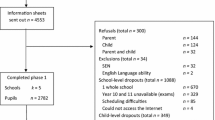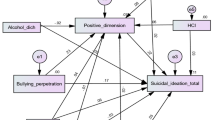Abstract
Previous studies have reported a longitudinal association between cybervictimization and suicidal thoughts and behavior. However, the relationship between cyber-perpetration and prospective suicide risk remains unclear. The sample was composed of 2150 at-risk adolescents (mean age 15.42), enrolled in Vocational Education and Training high schools in Israel. Cyberbullying, traditional bullying, depression, hostility, serious suicidal ideations, and suicide attempts were assessed through self-report questionnaires at the beginning of the school year and one year later. All types of victimization and preparation were cross-sectionally associated with suicide ideation and attempts. Longitudinal associations were found between cyber-perpetration and suicidal ideation/attempts. Cyber-perpetrators were found to be over twice more likely to report serious suicidal ideation (OR = 2.04) or attempt suicide (OR = 2.64) in the subsequent year compared to noninvolved adolescents. These associations were significant even after adjusting for baseline depression, hostility, and traditional bullying. Traditional bullying perpetration was prospectively associated with suicide attempts. Traditional victimization was cross-sectionally associated with suicide ideation and attempts but not prospectively. Cybervictimization was prospectively associated with suicide ideation but not to suicide attempts. The findings demonstrate the prospective risk of involvement in bullying in regard to suicide ideation and behavior. Cyberbullying was found to be a somewhat differentiated phenomena from traditional bullying.
Similar content being viewed by others
References
Olweus D (1993) Victimization by peers: antecedents and long-term outcomes. In: Teoksessa Rubin K, Asendorpf J (eds) Social withdrawal, inhibition and shyness in childhood. Hillsdale, NJ: Lawrence Erlbaum.
Smith PK, Mahdavi J, Carvalho M, Fisher S, Russell S, Tippett N (2008) Cyberbullying: its nature and impact in secondary school pupils. J Child Psychol Psychiatry 49(4):376–385
Cosma A, Walsh SD, Chester KL et al (2020) Bullying victimization: time trends and the overlap between traditional and cyberbullying across countries in Europe and North America. Int J Public Health 65(1):75–85
Harel-Fisch Y, Walsh DS, Shteinmitz N, Riez Y, Tesler R, Habib J (2016) Youth in Israel—health, well-being and patterns of risk behaviors: findings from the 7th International HBSC survey (2014). Bar Ilan Univ., Ramat Gan
Olweus D (2012) Cyberbullying: an overrated phenomenon? Eur J Dev Psychol 9(5):520–538
Wolke D, Lee K, Guy A (2017) Cyberbullying: a storm in a teacup? Eur Child Adolesc Psychiatry 26(8):899–908
Juvonen J, Gross EF (2008) Extending the school grounds?—Bullying experiences in cyberspace. J Sch Health 78(9):496–505
Slonje R, Smith PK (2008) Cyberbullying: another main type of bullying? Scand J Psychol 49(2):147–154
Kowalski RM, Limber SP (2007) Electronic bullying among middle school students. J Adolesc Health 41(6):S22–S30
Vandebosch H, Van Cleemput K (2009) Cyberbullying among youngsters: profiles of bullies and victims. New Media Soc 11(8):1349–1371
Kowalski RM, Giumetti GW, Schroeder AN, Lattanner MR (2014) Bullying in the digital age: a critical review and meta-analysis of cyberbullying research among youth. Psychol Bull 140(4):1073
John A, Glendenning AC, Marchant A et al (2018) Self-harm, suicidal behaviours, and cyberbullying in children and young people: systematic review. J Med Int Res 20(4):e129
Sampasa-Kanyinga H, Roumeliotis P, Xu H (2014) Associations between cyberbullying and school bullying victimization and suicidal ideation, plans and attempts among Canadian schoolchildren. PLoS ONE 9(7):e102145
Bannink R, Broeren S, van de Looij-Jansen PM, de Waart FG, Raat H (2014) Cyber and traditional bullying victimization as a risk factor for mental health problems and suicidal ideation in adolescents. PLoS ONE 9(4):e94026
Perret LC, Orri M, Boivin M et al (2020) Cybervictimization in adolescence and its association with subsequent suicidal ideation/attempt beyond face-to-face victimization: a longitudinal population-based study. J Child Psychol Psychiatry 61:866–874
Wright MF (2016) Cyber victimization on college campuses: longitudinal associations with suicidal ideation, depression, and anxiety. Crim Justice Rev 41(2):190–203
Klomek AB, Sourander A, Elonheimo H (2015) Bullying by peers in childhood and effects on psychopathology, suicidality, and criminality in adulthood. Lancet Psychiatry 2(10):930–941
Hinduja S, Patchin JW (2010) Bullying, cyberbullying, and suicide. Arch Suicide Res 14(3):206–221
Bonanno RA, Hymel S (2013) Cyber bullying and internalizing difficulties: above and beyond the impact of traditional forms of bullying. J Youth Adolesc 42(5):685–697
Bauman S, Toomey RB, Walker JL (2013) Associations among bullying, cyberbullying, and suicide in high school students. J Adolesc 36(2):341–350
Romero AJ, Wiggs CB, Valencia C, Bauman S (2013) Latina teen suicide and bullying. Hisp J Behav Sci 35(2):159–173
Schenk AM, Fremouw WJ, Keelan CM (2013) Characteristics of college cyberbullies. Comput Human Behav 29(6):2320–2327
Brent DA, Perper JA, Moritz G et al (1993) Psychiatric risk factors for adolescent suicide: a case–control study. J Am Acad Child Adolesc Psychiatry 32(3):521–529
Gámez-Guadix M, Orue I, Smith PK, Calvete E (2013) Longitudinal and reciprocal relations of cyberbullying with depression, substance use, and problematic internet use among adolescents. J Adolesc Heal 53(4):446–452
Fahy AE, Stansfeld SA, Smuk M, Smith NR, Cummins S, Clark C (2016) Longitudinal associations between cyberbullying involvement and adolescent mental health. J Adolesc Health 59(5):502–509
Gvion Y, Apter A (2011) Aggression, impulsivity, and suicide behavior: a review of the literature. Arch Suicide Res 15(2):93–112
Goldblatt MJ (2008) Hostility and suicide: the experience of aggression from within and without. Relating to self-harm and suicide: Psychoanalytic perspectives on practice, theory and prevention 95–108
Lemogne C, Fossati P, Limosin F et al (2011) Cognitive hostility and suicide. Acta Psychiatr Scand 124(1):62–69
Menon V, Sarkar S, Kattimani S, Mathan K (2015) Do personality traits such as impulsivity and hostility-aggressiveness predict the severity of intent in attempted suicide? Findings from a record based study in South India. Indian J Psychol Med 37(4):393
Benatov J, Nakash O, Chen-Gal S, Brunstein KA (2017) The association between gender, ethnicity, and suicidality among vocational students in Israel. Suicide Life-Threat Behav 47(6):647–659
Dalen JD (2012) The association between school class composition and suicidal ideation in late adolescence: findings from the Young-HUNT 3 study. Child Adolesc Psychiatry Ment Health 6(1):1–8
Tandon SD, Marshall B, Templeman AJ, Sonenstein FL (2008) Health access and status of adolescents and young adults using youth employment and training programs in an urban environment. J Adolesc Health 43(1):30–37
Klomek AB, Kopelman-Rubin D, Al-Yagon M, Berkowitz R, Apter A, Mikulincer M (2016) Victimization by bullying and attachment to parents and teachers among student who report learning disorders and/or attention deficit hyperactivity disorder. Learn Disabil Q 39(3):182–190
Paykel ES, Myers JK, Lindenthal JJ, Tanner J (1974) Suicidal feelings in the general population: a prevalence study. Br J Psychiatry 124(582):460–469
Derogatis LR (2000) BSI 18, Brief Symptom Inventory 18: administration, scoring, and procedures manual. NCS Pearson Inc., Minneapolis
Llorent VJ, Ortega-Ruiz R, Zych I (2016) Bullying and cyberbullying in minorities: are they more vulnerable than the majority group? Front Psychol 7:1507
Strohmeier D, Kärnä A, Salmivalli C (2011) Intrapersonal and interpersonal risk factors for peer victimization in immigrant youth in Finland. Dev Psychol 47(1):248
Wolke D, Woods S, Stanford K, Schulz H (2001) Bullying and victimization of primary school children in England and Germany: prevalence and school factors. Br J Psychol 92(4):673–696
Harel-Fish Y, Walsh S, Shtainmaz N, Lubel S, Raizz I, Tezler R, Haviv J (2016) Adolescents in Israel: health, psychological and social well-being and risk behavior patterns. World Heal Organ. HBSC repor
Akbulut Y, Sahin YL, Eristi B (2010) Cyberbullying victimization among Turkish online social utility members. J Educ Technol Soc 13(4):192–201
Wang J, Iannotti RJ, Nansel TR (2009) School bullying among adolescents in the United States: physical, verbal, relational, and cyber. J Adolesc Heal 45(4):368–375
Duarte C, Pittman SK, Thorsen MM, Cunningham RM, Ranney ML (2018) Correlation of minority status, cyberbullying, and mental health: a cross-sectional study of 1031 adolescents. J Child Adolesc Trauma 11(1):39–48
Hinduja S, Patchin JW (2011) Cyberbullying: a review of the legal issues facing educators. Prev Sch Fail Altern Educ Child Youth 55(2):71–78
Anderson CA, Bushman BJ (2002) Human aggression. Annu Rev Psychol 53(1):27–51
Klonsky ED, May AM (2015) The three-step theory (3ST): a new theory of suicide rooted in the “ideation-to-action” framework. Int J Cogn Therapy 8(2):114–129
Garandeau CF, Lee IA, Salmivalli C (2014) Differential effects of the KiVa anti-bullying program on popular and unpopular bullies. J Appl Dev Psychol 35(1):44–50
Volk AA, Camilleri JA, Dane AV, Marini ZA (2012) Is adolescent bullying an evolutionary adaptation? Aggress Behav 38(3):222–238
Caravita SCS, Di Blasio P, Salmivalli C (2009) Unique and interactive effects of empathy and social status on involvement in bullying. Soc Dev 18(1):140–163
de Bruyn EH, Cillessen AHN, Wissink IB (2010) Associations of peer acceptance and perceived popularity with bullying and victimization in early adolescence. J Early Adolesc 30(4):543–566
Duffy AL, Penn S, Nesdale D, Zimmer-Gembeck MJ (2017) Popularity: does it magnify associations between popularity prioritization and the bullying and defending behavior of early adolescent boys and girls? Soc Dev 26(2):263–277
van Den Broek N, Deutz MHF, Schoneveld EA, Burk WJ, Cillessen AHN (2016) Behavioral correlates of prioritizing popularity in adolescence. J Youth Adolesc 45(12):2444–2454
Reijntjes A, Vermande M, Goossens FA et al (2013) Developmental trajectories of bullying and social dominance in youth. Child Abuse Negl 37(4):224–234
Dijkstra JK, Lindenberg S, Veenstra R (2008) Beyond the class norm: bullying behavior of popular adolescents and its relation to peer acceptance and rejection. J Abnorm Child Psychol 36(8):1289–1299
Pouwels JL, Lansu TAM, Cillessen AHN (2016) Participant roles of bullying in adolescence: status characteristics, social behavior, and assignment criteria. Aggress Behav 42(3):239–253
Sentse M, Kiuru N, Veenstra R, Salmivalli C (2014) A social network approach to the interplay between adolescents’ bullying and likeability over time. J Youth Adolesc 43(9):1409–1420
Author information
Authors and Affiliations
Corresponding author
Ethics declarations
Conflict of interest
The authors declare they have no conflict of interest.
Ethical standards
The study has been approved by MOSAL’s and The College of Management and Academic Studies ethics committees and has therefore been performed in accordance with ethical standards.
Rights and permissions
About this article
Cite this article
Benatov, J., Brunstein Klomek, A. & Chen-Gal, S. Bullying perpetration and victimization associations to suicide behavior: a longitudinal study. Eur Child Adolesc Psychiatry 31, 1353–1360 (2022). https://doi.org/10.1007/s00787-021-01776-9
Received:
Accepted:
Published:
Issue Date:
DOI: https://doi.org/10.1007/s00787-021-01776-9




